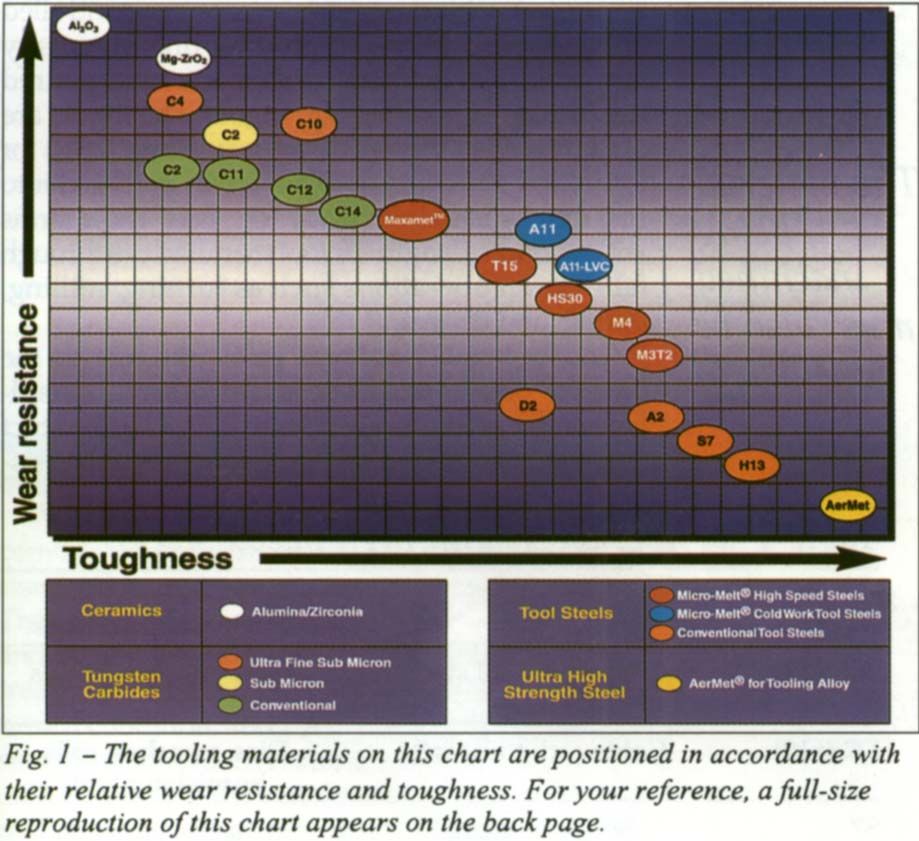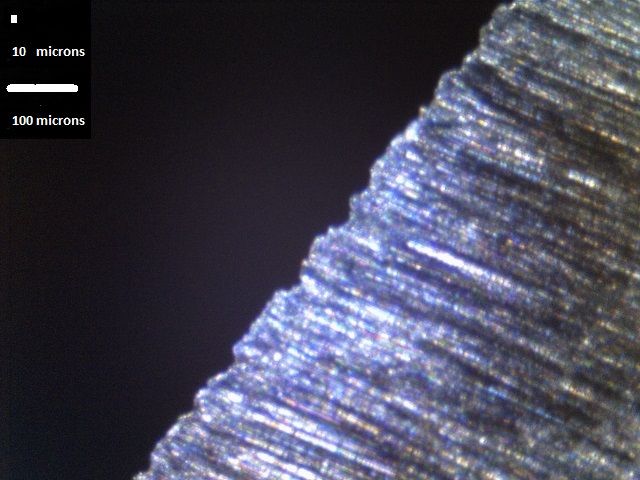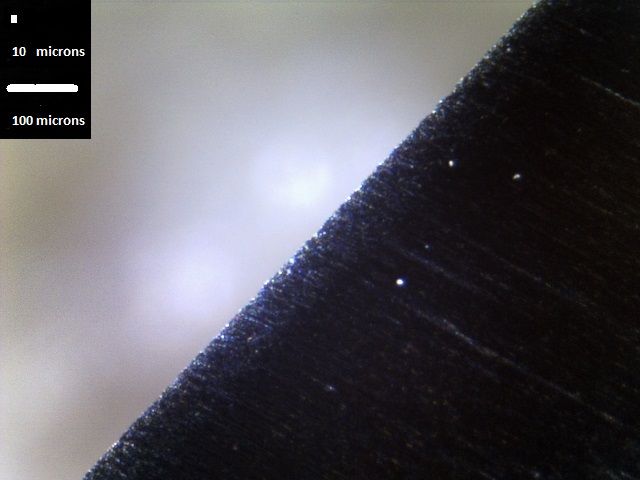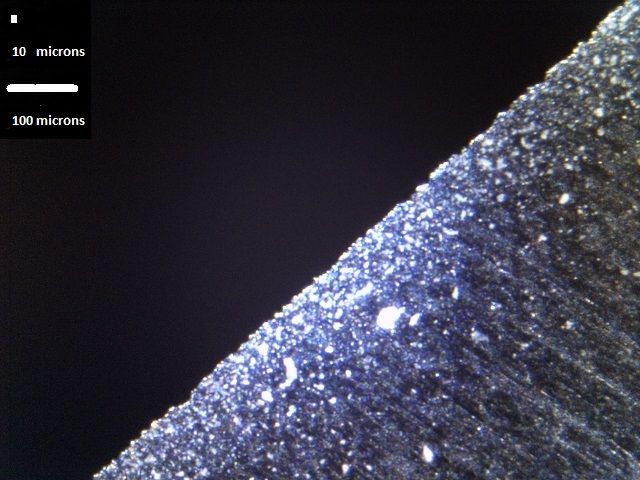Maxamet - the ultimate Mule steel
-
Cliff Stamp
- Member
- Posts: 3852
- Joined: Sat Dec 31, 2005 2:23 pm
- Location: Earth
- Contact:
Those single crystal alloys have been around for about 30 years, as with many of the very speciality alloys they often have many attributes which are necessary for their function but would have no value in knife blades. For example Stellite 6k is a very high performance super alloy in many applications but for knife blades it it hampered by the very low strength.
There are continuous advancements in alloys for cutting tools. Recently there have been significant advancements in ultra-hard ceramics coatings (exceeding the hardness of tungsten carbide) and even ultra low friction and high hardness diamond coatings. If the blades are being used in applications where they are mainly suffering slow wear then these coatings can have a tremendous improvement on blade life.
The problem with knives used in hand though is they are simply so thin and knife edges often dull by deformation/fracture. Ideally you would want a coating which would penetrate into the steel significantly and was simple to recoat.
But there are lots of things you can do with regular alloys by manipulating the microstructure. Imagine for example a blade made from 1095 which had :
-an ultra thin core, 0.010" thick at full hard martensite which was only partial blade height
-the microstructure gradually turns into lower bainite in the upper 50's
If you wanted to get really fancy :
-add a small amount of tungsten, niobium, vanadium to the core
-lower the carbon and add silicon and remove the alloy as you approach the spine/faces
This would produce a blade which had :
-tremendous strength
-very high wear resistance
but was also
-very easy to grind
-very tough/durable
If you wanted to get really fancy then as you approach the faces add chromium to make it stainless.
As of now we don't have the ability to manipulate the structure of steels on this level both in making them and as well hardening them, but research is always on going.
There are continuous advancements in alloys for cutting tools. Recently there have been significant advancements in ultra-hard ceramics coatings (exceeding the hardness of tungsten carbide) and even ultra low friction and high hardness diamond coatings. If the blades are being used in applications where they are mainly suffering slow wear then these coatings can have a tremendous improvement on blade life.
The problem with knives used in hand though is they are simply so thin and knife edges often dull by deformation/fracture. Ideally you would want a coating which would penetrate into the steel significantly and was simple to recoat.
But there are lots of things you can do with regular alloys by manipulating the microstructure. Imagine for example a blade made from 1095 which had :
-an ultra thin core, 0.010" thick at full hard martensite which was only partial blade height
-the microstructure gradually turns into lower bainite in the upper 50's
If you wanted to get really fancy :
-add a small amount of tungsten, niobium, vanadium to the core
-lower the carbon and add silicon and remove the alloy as you approach the spine/faces
This would produce a blade which had :
-tremendous strength
-very high wear resistance
but was also
-very easy to grind
-very tough/durable
If you wanted to get really fancy then as you approach the faces add chromium to make it stainless.
As of now we don't have the ability to manipulate the structure of steels on this level both in making them and as well hardening them, but research is always on going.
My whole professional career until the last two years has been in the refractory industry. Some refractory shapes are formed in an isostatic press, the advantages of this over standard vertical pressing is that you get pressure from all directions and improve densities. Also, you get the ability to change mixes through out the length of the shape. So you can have one mix that spends it's time in the steel bath, a mix that sits in the slag region and a mix that is above the bath.
I wonder if this could work in a powdered metal application. Like you are describing with the different steel qualities throughout the different knife areas.
Of course at what point are over complicating this? I mean we already have the ability to differentially heat (samurai sword)
I wonder if this could work in a powdered metal application. Like you are describing with the different steel qualities throughout the different knife areas.
Of course at what point are over complicating this? I mean we already have the ability to differentially heat (samurai sword)
-
Cliff Stamp
- Member
- Posts: 3852
- Joined: Sat Dec 31, 2005 2:23 pm
- Location: Earth
- Contact:
The problem with differential hardening is that it is very crude on the microscopic scale and thus it doesn't achieve what you would want ideals.
For example, when an edge blunts but isn't grossly damaged, then it is only a tiny amount of it which being affected, < 10 microns wide normally, < 100 microns wide in extreme cases where you cut until the blade is so dull you can see light strongly reflecting from the entire edge. However when a knife edge breaks from chipping then the damage is much wider, so much so that it can readily be seen.
Differentially hardened blades (or standard clads) have the entire edge at the hard/wear resistant part so while you get the edge holding/sharpening benefits you don't get the increased toughness/durability/ease of maintenance abilities of the differentially hardened part at all. As well you often get two extremes where you would ideally want a smooth transformation.
Now laminates can me made with more than two clads of course, just forge weld and then roll as a basic application, it just gets more complicated and very costly.
For example, when an edge blunts but isn't grossly damaged, then it is only a tiny amount of it which being affected, < 10 microns wide normally, < 100 microns wide in extreme cases where you cut until the blade is so dull you can see light strongly reflecting from the entire edge. However when a knife edge breaks from chipping then the damage is much wider, so much so that it can readily be seen.
Differentially hardened blades (or standard clads) have the entire edge at the hard/wear resistant part so while you get the edge holding/sharpening benefits you don't get the increased toughness/durability/ease of maintenance abilities of the differentially hardened part at all. As well you often get two extremes where you would ideally want a smooth transformation.
Now laminates can me made with more than two clads of course, just forge weld and then roll as a basic application, it just gets more complicated and very costly.
I wonder if something like that would be possible with the spray forming process- build up multiple layers with different alloys.Cliff Stamp wrote:Imagine for example a blade made from 1095 which had :
-an ultra thin core, 0.010" thick at full hard martensite which was only partial blade height
-the microstructure gradually turns into lower bainite in the upper 50's
-
BatCountry9
- Member
- Posts: 42
- Joined: Wed May 15, 2013 8:00 pm
-
Cliff Stamp
- Member
- Posts: 3852
- Joined: Sat Dec 31, 2005 2:23 pm
- Location: Earth
- Contact:
I have the mules, this isn't a standard high carbide steel, it is very difficult to grind.
To start I needed to sharpen the blades, I started with one of the ones which is optimized for toughness (the softer ones at ~64 HRC). This is how much of the blade was left to zero :
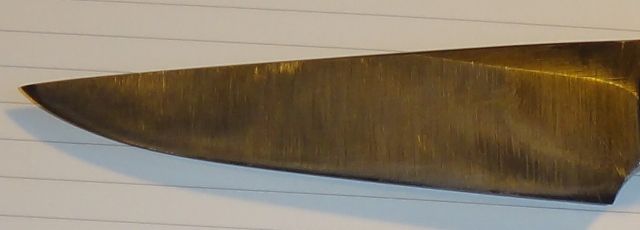
I asked Jeremy to grind it as close to zero as he felt comfortable, as you can see there is very little metal left at the edge you can barely see any marker left.
However it took six thousand passes with a Bester 700 waterstone to zero the bevel to 7.5 dps and again this is the Maxamet mule which is easy to grind.
Fun times ahead with the other two which are optimized for strength/wear resistance because they have a much lower grindability.
To start I needed to sharpen the blades, I started with one of the ones which is optimized for toughness (the softer ones at ~64 HRC). This is how much of the blade was left to zero :

I asked Jeremy to grind it as close to zero as he felt comfortable, as you can see there is very little metal left at the edge you can barely see any marker left.
However it took six thousand passes with a Bester 700 waterstone to zero the bevel to 7.5 dps and again this is the Maxamet mule which is easy to grind.
Fun times ahead with the other two which are optimized for strength/wear resistance because they have a much lower grindability.
-
Laethageal
- Member
- Posts: 543
- Joined: Wed Jan 23, 2013 6:24 pm
- Location: Lost in my thoughts
-
Cliff Stamp
- Member
- Posts: 3852
- Joined: Sat Dec 31, 2005 2:23 pm
- Location: Earth
- Contact:
I count them. I visualize the numbers running in my head I don't vocalize them as I am always watching something (documentary, etc.) when sharpening. I mark off every 50 passes on high volume grinding in the notes on the work then tally them up later.Apophis wrote:How do you track your pps when shaping?
I didn't plan to but I was forced to on the 69 HRC one as the Bester 700 didn't do much at all. It had a small flat (0.2 mm) on the edge and I had to use a ~50 grit ultra aggressive (loose bond) silicon carbide stone and even then hundreds of passes are needed to even see a difference under 50X linear magnification.Do you plan to use other (coarser) stones for the remaining mules?
I have A11, S125V, S110V, S90V, 121 REX, etc. .Laethageal wrote:Hey Cliff,
I was wondering, do you think the small wear resistance increase of maxamet over a11 is noticable at all?
One thing to remember is that wear resistance has two major forms (adhesive vs abrasive) and is split even among those forms, so for example the shock steels can have a higher wear resistance than the HSS when abrasive wear resistance is measured and the loads are high because then the abrasion takes place by fracture and not just ploughing. As well the size of the abrasive makes a difference as the manner of wear is different if the abrasive is much greater than vs if it is much smaller than the carbides. HSS in general will have much higher (usually) adhesive ratios, just look at the adhesive vs abrasive ratio of M2 vs D2.
In regards to that chart, look at the difference in "wear resistance" between A2 and D2, is is very similar to Maxamet vs A11 in absolute difference. How significant is the difference in wear resistance in D2 vs A2 and the general carbide related properties (grinding, edge toughness, etc.).
In general, very general, if you don't need high hot hardness there is little argument that those steels should be used over the cold work counterparts as they are generally much expensive both directly and indirectly. But comparing a ~70 HRC maxamet blade to a A11 blade which is > 5 HRC points softer with a very different micro-structure I would expect there to be some difference. If there was not then it would be hard to argue for example that ATS-34 at 60 HRC is so different than 420 at 55 HRC but the absolute differences are likely in the same class.
-
bornagainprimative
- Member
- Posts: 234
- Joined: Thu Jan 30, 2014 6:53 am
- Location: Southern Ontario, Canada
-
Cliff Stamp
- Member
- Posts: 3852
- Joined: Sat Dec 31, 2005 2:23 pm
- Location: Earth
- Contact:
Not yet, I need to do more work with it.bornagainprimative wrote:Cliff have you made a video on maxamet yet?
In regards to cutting ability, these knives are zero ground to 7.5 dps primary bevels. As a point of reference for how well they cut, I just finished a cardboard run with one which at the end had a sharpness of 1.5% of optimal (it wasn't very sharp). It cut 3/8" sisal with 11-12 lbs of force on a 2" draw (hemp numbers are is lower).
I am finding an issue with sharpening them though which is that it isn't very easy to get high quality edges from the Bester 700 as prep for the DMT 600 micro-bevel I run in a lot of stock tests. But I don't have a lot of experience with the steel yet and it just takes so long to grind it.
After the cardboard run it took 1000 passes per side (2000 total) on the Bester 700 to apex the bevel again. Because this is so long the edges tend to be over ground and fairly coarse. I think I may have to apex with a 2-3k stone before the 600 DMT.
Re: Maxamet - the ultimate Mule steel
I just wanted to see if there have been any developments on this project. Very interested in the topic..
Re: Maxamet - the ultimate Mule steel
Hi Mikeku,
Welcome to our forum.
We will be making a Mule Team run with Maxamet. Carpenter has informed us that they are doing the melt now. It will for sure be expensive, but I don't think there will be too many opportunities in the near future to play with this "stuff" other than something like Mules.
Cliff, please share your findings. You might be able to safe us some grief on the run. What do you feel is the optimal hardness?
sal
Welcome to our forum.
We will be making a Mule Team run with Maxamet. Carpenter has informed us that they are doing the melt now. It will for sure be expensive, but I don't think there will be too many opportunities in the near future to play with this "stuff" other than something like Mules.
Cliff, please share your findings. You might be able to safe us some grief on the run. What do you feel is the optimal hardness?
sal
Re: Maxamet - the ultimate Mule steel
Gentlemen,
I've been interested in the hard wear steels, I just dont feel that I have the means to help you juggernauts progress the industry in a scientifically meaningful way. I love the progression of this MAXAMET project for it's insane wear resistance. I'm just hoping to gently push the discussion in a direction that will benefit the industry. I feel like this is a chemical composition worth the time.
With Grave Reverence,
Mike
I've been interested in the hard wear steels, I just dont feel that I have the means to help you juggernauts progress the industry in a scientifically meaningful way. I love the progression of this MAXAMET project for it's insane wear resistance. I'm just hoping to gently push the discussion in a direction that will benefit the industry. I feel like this is a chemical composition worth the time.
With Grave Reverence,
Mike
-
Laethageal
- Member
- Posts: 543
- Joined: Wed Jan 23, 2013 6:24 pm
- Location: Lost in my thoughts
Re: Maxamet - the ultimate Mule steel
Well I know Cliff did some testing on sharpening this mule and that low grit stone leaved some pretty bad fracture at the edge. Seems to me he still want to do more testing before giving out results. He posted it both on his website forum and on the carpet cutting testing thread he made a few days ago:
Cliff Stamp wrote: In some detail, as you move into the very hard and high carbide steels it is easy for the apex to start to break apart with the shaping grit and if you don't take care here you will see the fracture have an influence in lowing the edge retention/durability even if you micro-bevel because the fracture is deeper than what you see. For example these are some shots of MaxaMet which is similar to 121REX being an ultra-high carbide steel :
This is the edge apexed with the Bester 700, note how the apex breaks apart larger than the scratch lines. If you go lower than the Bester 700 the apex can literally explode. Here is what happens when I apexed it with a TASK which has a grit rating of ~100 :
This however is what the apex should look like before the micro-bevel to get maximum performance, it was produced by a Naniwa Aotoshi :
But that is a 2k stone and very slow cutting. The Naniwa Superstone 400 is a much more coarse stone but gets you to a very nice apex level and cuts fast enough it can be used for shaping :
Now if you have the time/inclination, a more optimal approach is to work with say the Naniwa Superstone 400 until you just start to see the light be removed from the apex and then switch to the Aotoshi. But the problem is that the very slow cutting action means if you don't judge the transition exactly right you will be grinding a long time and doing little to nothing. This is why most people just maximum burr sharpen as it is very fast compared to trying to minimize burr sharpen.
But you waste a lot of steel if you sharpen that way (constantly create heavy burrs) and when I really start to work with a knife I can sharpen it several times in one day, if I sharpened using heavy burr formation I would increase the rate of steel loss many times to one and burn up the knives much quicker. The way I sharpen doesn't remove any more steel than what was lost in the cutting itself, speaking of the width of the knife of course.
-
Cliff Stamp
- Member
- Posts: 3852
- Joined: Sat Dec 31, 2005 2:23 pm
- Location: Earth
- Contact:
Re: Maxamet - the ultimate Mule steel
Sal, there are two ways to approach it, one is to optimize it for toughness and the other for strength/wear resistance. Here are the two cycles :sal wrote:
What do you feel is the optimal hardness?
> a) austenize at 2225 F, oil quench, temper at 1000 F, cryo, two more tempers at 1000 F
> b) austenize at 1950F, oil quench, three 2 hour tempers at 1025
I am still working with the blades, if you want a sample of each I can send them to you. I actually had six of them made.
If you just want an off-the-cuff answer - I would pick the first one, it would be a steel which is going to be very different than what most people have experienced and would be a very unique mule.
How unique? Well for example I can take it and cut directly into a sharpening stone and it has almost no effect on the apex at all (edge won't reflect light) but the same would flatten a S30V blade easily.
